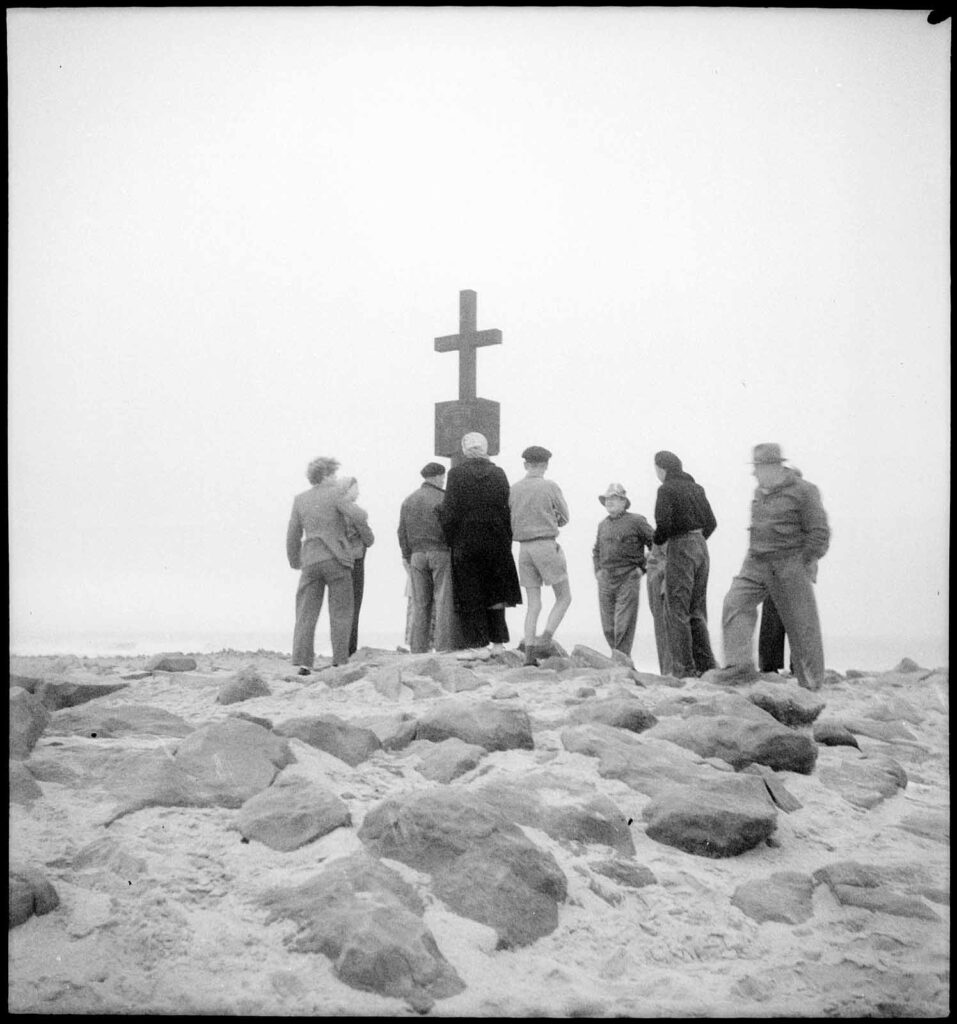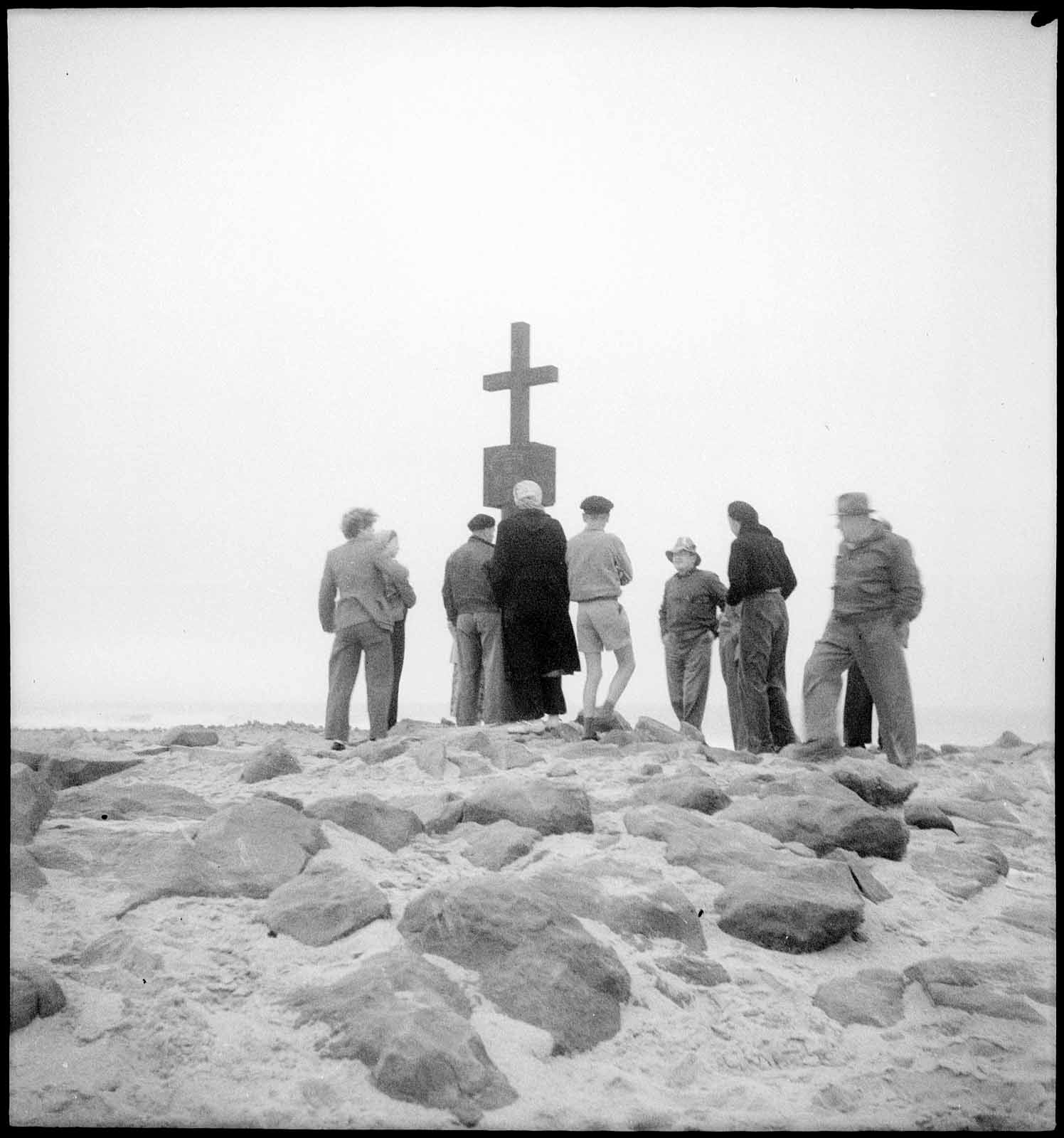By: Dag Henrichsen (Basler Afrika Bibliographien)
Originally Published 20 November 2020 [LINK TO ORIGINAL]
When we reflect about ‘Cape Cross’, we should ask whether we talk about an object of some historical significance – the 15th century Portuguese stone pillar padrão – or a culturally defined landscape: the space and place to the north of Henties Bay. The padrão, of which three replicas exist – two at ‘Cape Cross’ and one at the Swakopmund Museum – are symbols of imperial maritime exploration and imagination. They mark the beginning of global European expansion along the southern African coast, in the wake of which colonial conquest of the continent progressed. When imperial Germany explored the coast north of Walvis Bay in the early 1890s and stumbled across the padrão, by then toppled, it was removed and shipped to Berlin. A first replica, to which the German imperial crest was added beside the Portuguese one, was erected on the spot. The Portuguese original was on display in the German Historical Museum until last year before being repatriated (it seems) to Namibia. A second replica at Cape Cross was erected in the 1980s.
It was European imperial history which made ‘Cape Cross’ and we continue to call it as such, as though the place is devoid of its African history. However, from the perspective of local African histories we are offered a plethora of other names, for example Otjozondera (in Otjiherero) or (Kai)ǁganabes or ǁGanaǁKhuibes (in Khoekhoegowab). Typically, they do not feature on any modern map. ‘Cape Cross’ is a typical expression of a colonial praxis which entailed erasure and suppression of African history, including place names, on a large scale.

The spatial maps of historical Namibians looked rather differently. These maps, actively memorised until today, uphold and, indeed, continually reclaim space and places. They provide entry points to multiple African memories, histories and conceptualisations. In the case of ‘Cape Cross’, the padrão is irrelevant for these African local histories, and this is not surprisingly. Indeed, ‘Cape Cross’ is important for what it is: an African place, space and landscape of various people’s histories, experiences, and claims.
Otjiherero-speaking people nowadays refer to ‘Cape Cross’ as Otjozondera – the place of birds – and root this name ‘in’ the local history of a clan, typically expressed through so-called praise poetry. One praise poem (omutandu), or rather a fragment of it, as narrated by the historian Alex Kaputu, reads as follows:
Otjozondera – [‘The place of birds’]
Oko’ vinjoko -[‘To the places of your mother’]
Vio zongombe za hiya kOtjimbumba tjozongomb’ ozombaranga – [‘The places of the cattle of the house of Otjimbumba (which is the house of Kamapunga) who did not stay long’]
Mu mu hari imue jo njapi noja ngotonja – [‘They were all together (as one) […]’]
Damara people, in turn, associate ‘Cape Cross’ in Khoekhoegowab with at least two names, according to the historian Hans Axasi ǂEichab:
(Kai)ǁganabes – [‘The water of dumb (scared) people’]
ǁGanaǁKhuibes – [‘The place of the missing camelthorn tree’]
These names and text fragments fuse space and time, nature and history, people and animals. Importantly, they reflect a praxis of living with the land, conceptualizing and presenting it in particular aesthetic ways and forms. Praise poetry refers to a genre of narration and performance in which names, stories, melody, dance and mimics are often fused – and this holds true for place name poems in Otjiherero as well as Khoekhoegowab. Through narration and performance praise poetry transforms space into place and territory into a culturally defined landscape. As a genre, they are key to an understanding of pre-colonial history and thought, crucial for upholding land claims during the colonial period and they continue to inform post-colonial politics and even pop-music.
The names and narratives relating to Otjozondera or (Kai)ǁganabes or ǁGanaǁKhuibes associate particular people and families to ‘Cape Cross’ or characterise the place with regard to natural features. The reference to birds in the name Otjozondera is not accidental. The area housed century-old bird colonies, and early Europeans targeted their enormous and very lucrative guano deposits first – and only later the current seal colonies – when exploring the economic potential of the coast to the north of Otjozondjii (Swakopmund). All three names and texts provided here make clear that particular people knew, visited, and at least temporarily resided at ‘Cape Cross’. Their texts reflect a praxis of storing historical and biographical information in the landscape and simultaneously naturalising lived history. Despite the desolate environment and scarcity of ground water, ‘Cape Cross’ was, as these texts inform us, a place of African belonging. Not surprisingly, graves, too, emphasise this, as is reflected in the history of the Dâure Daman, a community with ancient settlements in the wider Dâures (Brandberg) area of western Namibia.
Conceptualising and thus mapping and claiming a place and space like ‘Cape Cross’ along the coast included experiences with ‘people coming from the sea’. In 1836 a Herero woman explained to the British traveller James Alexander how people moved towards the coast and managed coastal trade:
‘The women left the men with the cattle, and were taken across in a boat to the other side, where white men wearing hats were seen; these people we call Oban [Ovandu= people] … With the Oban we exchanged our cattle for iron to make javelins, for copper to make beads, and we also got knives and calabashes from them. We would not allow the Obans to come into our country.’
This text not only highlights the importance of women´s roles in conducting coastal trade, but it emphasises the importance of maintaining control. A Damara poem, recorded by the anthropologist Viktor Lebzelter in the late 1920s and referring to people coming from the sea, emphasises the necessity of being cautious with regard to these ‘unknown people’. It states: ‘We cannot sleep’. Obviously, coastal engagements with ship crews, whale hunters, and guano miners led to multiple experiences and also conflict. After all, these texts emphasise acting cautiously and maintaining control. These recorded texts, too, reinforce the conceptualisation of historical belonging. The padrão as an object does not feature in any of this. Rather, historical coastal experiences of people with reference to place, space and landscape mattered.
The names and poems in Otjiherero and Khoekhoegowab need to be viewed, as a few scholars such as Jekura Kavari, Anette Hoffmann and Larissa Förster have suggested, as ‘invisible monuments’ in which performed memory and people matter, rather than material objects. Indeed, central Namibian memory culture is not necessarily tied to material objects as displayed in a museum but rather to intangible cultural productions which appeal to the audio-visual senses in complex ways, and which tune and turn the minds and bodies of people. Listening to praise poetry was – and is – seeing history, experiencing history, and constructing a public history. We need to listen to narratives about Otjozondera and (Kai)ǁganabes and ǁGanaǁKhuibes in order to understand ‘Cape Cross’. And we need to convince museums to ‘see history’ whilst listening.
